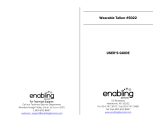
Killion and Niquette, 2000; Taylor, 2003). One person with a 50 dB pure tone average
hearing loss but little or no SNR Loss may report little or no difficulty hearing in noise with
hearing aids, while another person with the same pure tone average loss but severe SNR
Loss may require an FM system in order to understand speech in noise. Similarly, word
recognition in quiet is not a reliable predictor of performance in noise.
BKB-SIN TEST METHODOLOGY
The BKB-SIN Test uses the Bamford-Kowal-Bench sentences (Bench and Bamford, 1979;
Bench, Kowal and Bamford, 1979) spoken by a male talker in four-talker babble (Auditec
of St. Louis, 1971). The BKB-SIN contains 18 List Pairs. Each
List Pair consists of two
lists of eight to ten sentences each. The first sentence in each list has four key words, and
the remaining sentences each have three. A verbal “ready” cue precedes each sentence.
The key words in each sentence are scored as correct or incorrect. The sentences are
presented at prerecorded signal-to-noise ratios that decrease in 3-dB steps. List Pairs 1-8
have ten sentences in each list, with one sentence at each SNR of: +21, +18, +15, +12,
+9, +6, +3, 0, -3 and -6 dB. List Pairs 9-18 have eight sentences in each list, with one
sentence at each SNR of: +21, +18, +15, +12, +9, +6, +3 and 0 dB. Each list in the pair
is individually scored, and the results of the two lists are averaged to obtain the List Pair
score. Results are compared to normative data to obtain the SNR Loss.
Choice of Speech and Babble
Sentence Materials
In any speech-in-noise test, the choice of speech and background noise presents a
compromise between realism and reproducibility. Monosyllabic words, recorded and
played back at uniform, controlled intensity levels, are not representative of speech in
the real world. Sentences spoken with natural dynamics have greater dynamic range
than monosyllabic words, and are thus a more valid representation of real speech
(Villchur, 1982).
The Bamford-Kowal-Bench sentences consist of 21 lists, each containing 16 sentences
(336 total sentences). The sentences were derived from language samples elicited from
young hearing-impaired children (Bench and Bamford, 1979; Bench, Kowal and Bamford,
1979) and are at approximately a first-grade reading level (Soli and Nilsson, 1994).
According to Bench et al. (1979) the vocabulary and grammar should be familiar to
children because the sentences were produced by children, and in constructing the
sentences, the investigators gave preference to the words produced by the younger and
more hearing-impaired children. Sentence length is seven syllables or less for most of the
sentences.
17





















